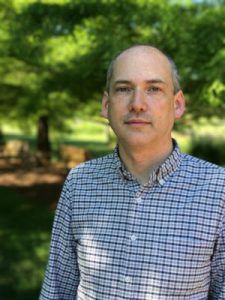Iowa State gains faculty learning communities

Courtesy of the Center for Excellence in the Arts and Humanities
Carlton Basmajian, associate professor of community and regional planning and director of the Center for Excellence in the Arts and Humanities, laid the groundwork for the five new faculty learning communities at Iowa State.
November 10, 2019
Iowa State’s student learning communities were created in 1995. Today, the university boasts more than 90 student learning communities focused on an array of topics and a 77 percent participation rate among first-year students.
Iowa State’s faculty are now delving into the learning community arena for themselves.
These faculty learning communities started with a chance conversation at a conference.
“A couple of years ago, I was at a conference sitting next to someone from the University of Georgia who was a landscape architect, and he mentioned he was part of a faculty learning community,” said Carlton Basmajian, associate professor of community and regional planning and director of the Center for Excellence in the Arts and Humanities, in a press release. “He said, ‘Faculty from a lot of different departments get together around a common idea and meet and chat.'”
Basmajian brought the idea of faculty learning communities to vice president for research Sarah Nusser, and now the first five communities have been formed and will work throughout the academic year to address the issues they are researching.
the Center for Excellence in the Arts and Humanities directs the communities, but they are open to faculty across campus. One of the goals of the communities is to bring together faculty from several colleges and departments with different backgrounds and expertise.
In April, the Center for Excellence in the Arts and Humanities, in conjunction with the Office of the Vice President for Research, asked faculty members to submit proposals for new faculty learning communities focused on a particular topic.
As a result of the call for proposals, five new faculty learning communities were selected to receive $1,000 in seed funds to further develop their outreach beginning fall semester 2019. The focus areas and faculty leaders of the new learning communities follow.
“Augmented Reality Enhancing Intercultural Competence and Second Language Learning” with Shenglan Zhang, assistant professor of world languages and cultures, as the faculty leader.
This community seeks to share information related to the application, language and culture of augmented reality, and also explore funding opportunities that enhance students’ intercultural communication skills and second language learning, according to the Center for Excellence in the Arts and Humanities website.
“The Crises of Contemporaneity” with April Eisman, associate professor of art and visual culture, as the faculty leader.
This learning community of interdisciplinary scholars will focus on some of the challenges that neoliberalism poses for the future of civilization, including current threats to democracy as well as the planet as a whole, and through readings and discussions explore possible alternatives to it, according to the Center for Excellence in the Arts and Humanities website.
“Interdisciplinary Approaches to Research and Community Engaged Coursework in Perry, Iowa” with Megan Jeanette Myers, assistant professor of world languages and cultures, as its faculty leader.
The purpose of this learning community is to foster conversations between cross-disciplinary faculty members who are conducting research projects and designing community-engaged courses in Perry, Iowa, according to the Center for Excellence in the Arts and Humanities website.
“Sustainable Peace” with Christina Campbell, associate professor of food science and human nutrition, as its faculty leader.
This learning community will explore, learn and discuss the meaning of peace, particularly positive peace, in the context of teaching, research and outreach. Positive peace means living in a world that is just and sustainable, including access to food and clean drinking water, education, security and other human rights, according to the Center for Excellence in the Arts and Humanities website.
“Water Scholars Program” with Richard Cruse, professor of agronomy, as its faculty leader.
Water resource management issues touch all academic disciplines, making it a top priority for many interdisciplinary research teams. This learning community aims to banish the barriers between the arts and sciences to help campus researchers think creatively and work together to come up with novel water resources research, according to the Center for Excellence in the Arts and Humanities website.
“The idea behind creating faculty learning communities is to develop an ecosystem of faculty collaborators who will eventually take their work and interests to the next level, such as publish articles, develop symposia, apply for grants, create courses or generate other scholarly output,” Basmajian said. “We’re hoping to provide opportunities for people from different sides of campus to make meaningful connections.”
At the end of the spring semester, each group will submit a short report about what it accomplished.






